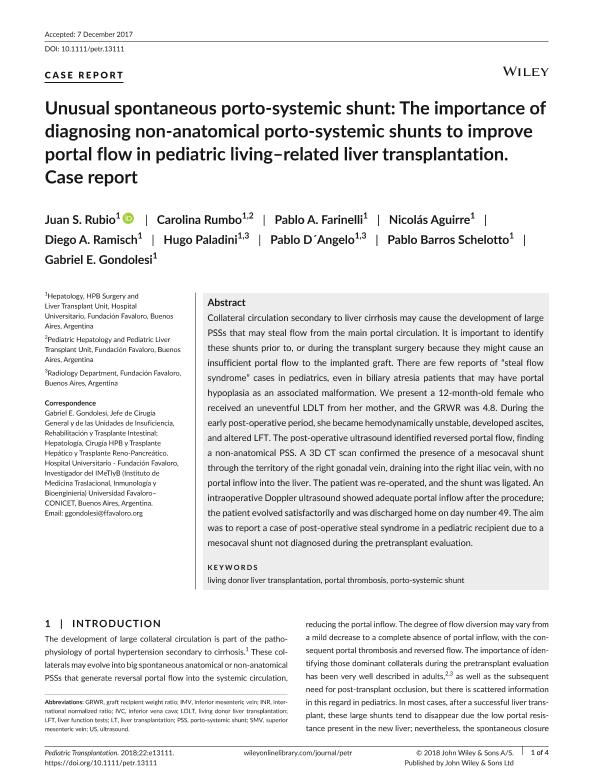Artículo
Unusual spontaneous porto-systemic shunt: The importance of diagnosing non-anatomical porto-systemic shunts to improve portal flow in pediatric living–related liver transplantation. Case report
Rubio, Juan S.; Rumbo, Carolina; Farinelli, Pablo A.; Aguirre, Nicolás; Ramisch, Diego A.; Paladini, Hugo; D´Angelo, Pablo; Barros Schelotto, Pablo; Gondolesi, Gabriel Eduardo

Fecha de publicación:
03/2018
Editorial:
Wiley Blackwell Publishing, Inc
Revista:
Pediatric Transplantation
ISSN:
1397-3142
Idioma:
Inglés
Tipo de recurso:
Artículo publicado
Clasificación temática:
Resumen
Collateral circulation secondary to liver cirrhosis may cause the development of large PSSs that may steal flow from the main portal circulation. It is important to identify these shunts prior to, or during the transplant surgery because they might cause an insufficient portal flow to the implanted graft. There are few reports of “steal flow syndrome” cases in pediatrics, even in biliary atresia patients that may have portal hypoplasia as an associated malformation. We present a 12-month-old female who received an uneventful LDLT from her mother, and the GRWR was 4.8. During the early post-operative period, she became hemodynamically unstable, developed ascites, and altered LFT. The post-operative ultrasound identified reversed portal flow, finding a non-anatomical PSS. A 3D CT scan confirmed the presence of a mesocaval shunt through the territory of the right gonadal vein, draining into the right iliac vein, with no portal inflow into the liver. The patient was re-operated, and the shunt was ligated. An intraoperative Doppler ultrasound showed adequate portal inflow after the procedure; the patient evolved satisfactorily and was discharged home on day number 49. The aim was to report a case of post-operative steal syndrome in a pediatric recipient due to a mesocaval shunt not diagnosed during the pretransplant evaluation.
Archivos asociados
Licencia
Identificadores
Colecciones
Articulos (IMETTYB)
Articulos de INSTITUTO DE MEDICINA TRASLACIONAL, TRASPLANTE Y BIOINGENIERIA
Articulos de INSTITUTO DE MEDICINA TRASLACIONAL, TRASPLANTE Y BIOINGENIERIA
Citación
Rubio, Juan S.; Rumbo, Carolina; Farinelli, Pablo A.; Aguirre, Nicolás; Ramisch, Diego A.; et al.; Unusual spontaneous porto-systemic shunt: The importance of diagnosing non-anatomical porto-systemic shunts to improve portal flow in pediatric living–related liver transplantation. Case report; Wiley Blackwell Publishing, Inc; Pediatric Transplantation; 22; 2; 3-2018; 1-4
Compartir
Altmétricas



